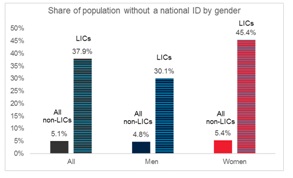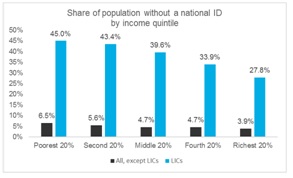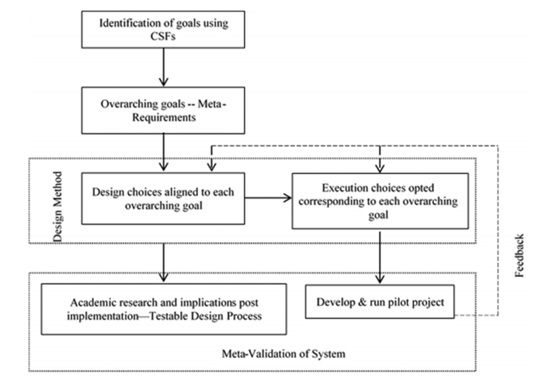Featured Science
Introduction
Identity is one of the basic building blocks of the Fourth Industrial Revolution,and philosophicallyexplains "who am I?" It is formed of attributes that make an individual unique and distinguishable from the rest of the population(Olson, 2015). As the capability of digital technologies improves drastically in the last decade, identity in digital form has become unavoidable. The World Economic Forum (WEF) defines digital identity as "collection of individual attributes thatdescribe an entity and determine the transactions in which that entity can participate". Identity entitles an individual to various services like voting, education, employment, insurance, healthcare etc. (Mir, Kar, Gupta, & Sharma, 2019). Yet there are around 1 billion people in the world at present that do not possess any form of official identity. Lack of identity has a significant impact on people living in rural areas, especially women, children, and financially backward families. The appropriation of benefits and services from the government for its residents becomes difficult without establishing the identity of individuals uniquely. Such services could be directly through government entities (say, financial, banking, PDS, etc.), through private partners (like telecom, digital payments) or in public-private partnership mode (literacy missions, etc.). In recently released Sustainable Development Goal-16 by the UN, it has been recommended that by 2030, every individual should be given a legal identity. India's digital identity program –Aadhaar is one significant contribution in this direction considering its coverage. Rolling out a national identity scheme needs a considerable budget, time and most importantly, domain knowledge for smooth implementation.
Traditional identity documents are not compatible with today's digital needs. There is a need to have trusted and secured digital identities that would facilitate faceless transaction online. Digital identities can have a positive socio-political and economic impact for a country, especially emerging ones if designed and implemented correctly across different application areas(McKinsey, 2019).It is difficult to uniquely identify a person without biometrics, which requires a digital identity system. Considering the fact that at present 24% of the developing countries do not possess any DI system and only 3% have a basic identity scheme which could be used in both online and offline sphere, there is a need to improve these numbers. Countries that do not have any national level identity program will need guidelines to follow such that, "identity for all" objective is achieved. At present, Aadhaar is a leading example to follow for benchmarking the objectives of DI scheme, given the coverage of the number of people who have subscribed to services through Aadhaar.
India became the first nation with a population exceeding 1 billion citizens to implement digital identity for all its citizens. With a population of 1.3 billion(Bank, 2016), India is the second most populous country in the world. For such a country to roll out a program likeAadhaar, which is world's most extensive digital identity program as of January 2020 in itself is a big challenge considering various practical challenges like high illiteracy rate (26% as per 2011 census), diverse cultures, political beliefs, varied demographics and many more.Aadhaar by design is meant for establishing the identity of individuals but not for determining citizenship. Aadhaar is an initiative by the Government of India that is intended to provide every resident of India a unique identity number. It addresses the "identity gap" of India(Gelb & Clark, 2013). This unique identification number is tightly coupled with the individual's biometrics like their photograph; fingerprint's of both hands and iris scan(Weinberg, 2016). This Aadhaar number is used by both private and public sector platforms as proof of address where ever required. The Aadhaar platform is indicative of the changing forms of a state and citizen relation in which the citizens are regularly redefined as customers of government for services. Aadhaar is aligned with the main elements of SDGs-16 (UNGA, 2016), i.e. the right to identity and development of a sound system to guarantee social protection by preventing leakages and mismanagement in various welfare schemes, absence of identification documents, scalability, lack of a trusted platform for financial transactions and the presence of a large number of fake beneficiaries.
In 2017 ID4D and 2017 Global Findex conducted a joint survey of 99 countries on identity coverage, use, and barriers to access. Findings suggest that people from low income countries, especially women and the poor, 40% of the total population are significantly affected by the lack of ID(Desai, Diofasi, & Lu, 2018).


Where LIC is low income countries. (Source: World Bank Report on Global Identification 2018) |
E-government projects fail because of multiple reasons.According to the U.S government survey, the major issues concerned with e-government are policy issues rather than technical, and that includes coordination and collaboration among the agency leaders, agency specific thinking instead of focusing on the overall objectives and functionalities of e-government, and communication between different stakeholders of different e-government projects for the smooth functioning of the system(Egov, 2003). Apart from these complex policy issues, there are other dimensions like social and cultural aspects that play a vital role in doing an e-government project a successful one(Jaeger & Thompson, 2003; L.Chang, 2002).
Research methodology
In our study (Umar et al., 2020), we have attempted to analyse the design and implementation goals for this digital identity platform. In this study, based on the Design Theory employed to analyse the process of developing a digital identity system in India, a design theory specific for developing digital identity system is proposedthat could be helpful forother countries.The Best Worst method of multi-criteria decision making has been used for analysing the data and insights elicited from the experts.

Source: (Mir, Kar, Dwivedi, Gupta, & Sharma, 2019)
Overview of findings
The authors identified nine primary objectives of a digital identity system and concluded uniqueness, and privacy and security as the drivers of the digital identity system whereas inclusion, identity as the platform, future-proofing of technology and scalability as the dependent objectives(Mir, Kar, Dwivedi, et al., 2019).Remaining three objectives, i.e. convenience, cost and speed form linkages and lie in-between drivers and dependent objectives, as shown in the figure below.

Source: Adapted from(Mir, Kar, Dwivedi, et al., 2019)
Assessing the impact and efficiency of e-government projects is a key measure in deciding whether a project is a successful one. In the Indian context, Harijit Singh, Arpan Kar and Vigneswara Ilavarsan in their paper titled Assessment of e-Governance Projects: an Integrated Framework and its Validation, presented in ICEGOV2017 conference, developed an integrated framework for the assessment of e-government projects. Assessment is done based on the dominant constructs of five major groups, i.e. people, technology, policy, institution and economic status. For people group, these are ease of use, usefulness, user awareness & satisfaction, adoption and social benefits & influence. For technology group, these are accessibility, infrastructure, reliability and website maturity. For policy group, these are laws & policies, privacy & security, transparency & user trust and effectiveness & empowerment. Foreconomic group, these are affordability & cost of service and funding sustainability. For institution group, theseareavailability & performance, management support, quality (system, service and information) and operational efficiency. Further, the proposed framework is evaluated using two case studies: Passport Project of Ministry of External Affairs (a central governmentinitiative, for citizens), and the Excise Supply Chain Information Management Systems for Liquor distribution in Delhi (a stategovernment initiative for businesses)(Singh, Kar, & Ilavarasan, 2017).
In 2019, McKinsey published a white paper titled Digital Identification: A key to Inclusive Growth in which they highlighted the potential benefits of "good" digital identity for institutions as well as individuals. The report based on seven countries estimated that digital identity has the potential to unlock economic value equivalent to 3% to 13% of GDP in 2030. In addition to that, digital identity could enable 1.7 billion people globallyto gain access to financial services, reduce payroll related fraud in emerging economies by 20%, up to 90%reduction in customer onboarding costs, and speedup the e-government service delivery by multi-fold(McKinsey, 2019).
Conclusion
To conclude, it is always a good practice to benchmark with an on-going system which has been implemented at a very large scale as a reference when developinga similar one for a different audience. It has been estimated that the total cost of a typicaldigital identity system is in-between £100-250 million(Open Identity Exchange, 2018). Hence, it is important toanalyse each risk beforehand and have measures to avoid or mitigate these types ofrisks. Further, digital identity could save £5-10 billion by avoiding identity-relatedfrauds.Aadhaar as a case study can help concerned authorities like governments to make policies that have thepossibility of creating a significant impact on the population. Insights from the planning and implementation of Aadhaar will be valuable information while making feasibility analysis interms of time required to develop an identity system, the budget required, technologicalrequirements, the skillset of manpower, the longevity of the project, robustness of identity system and overall management of the project.
Umar Bashir Mir, Arpan K Kar, MP Gupta
Information Systems Area, Department of Management Studies, IIT Delhi
Disclaimer: This work has been submitted by the author. Any opinions, findings, conclusions or recommendations expressed in this article are those of the authors only.